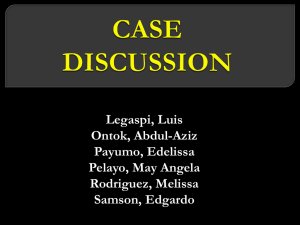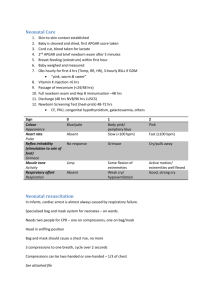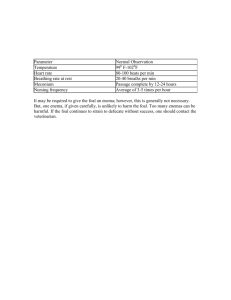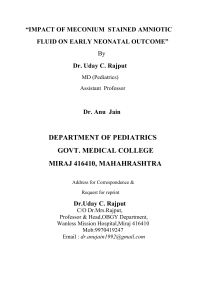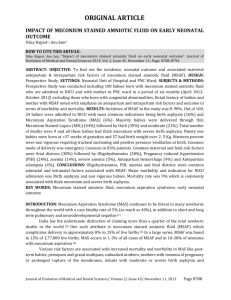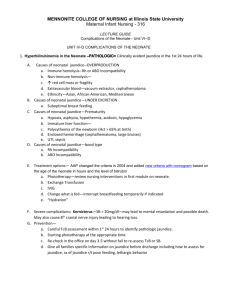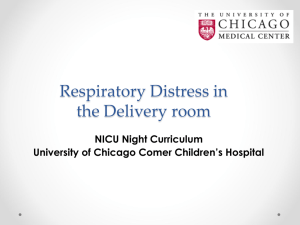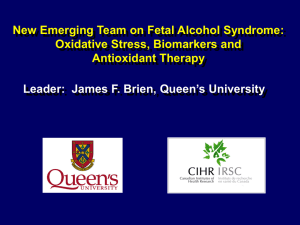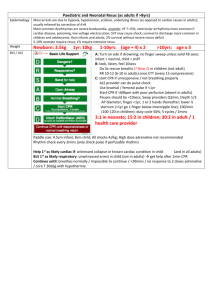original article clinical study of meconium stained liquor at term
advertisement
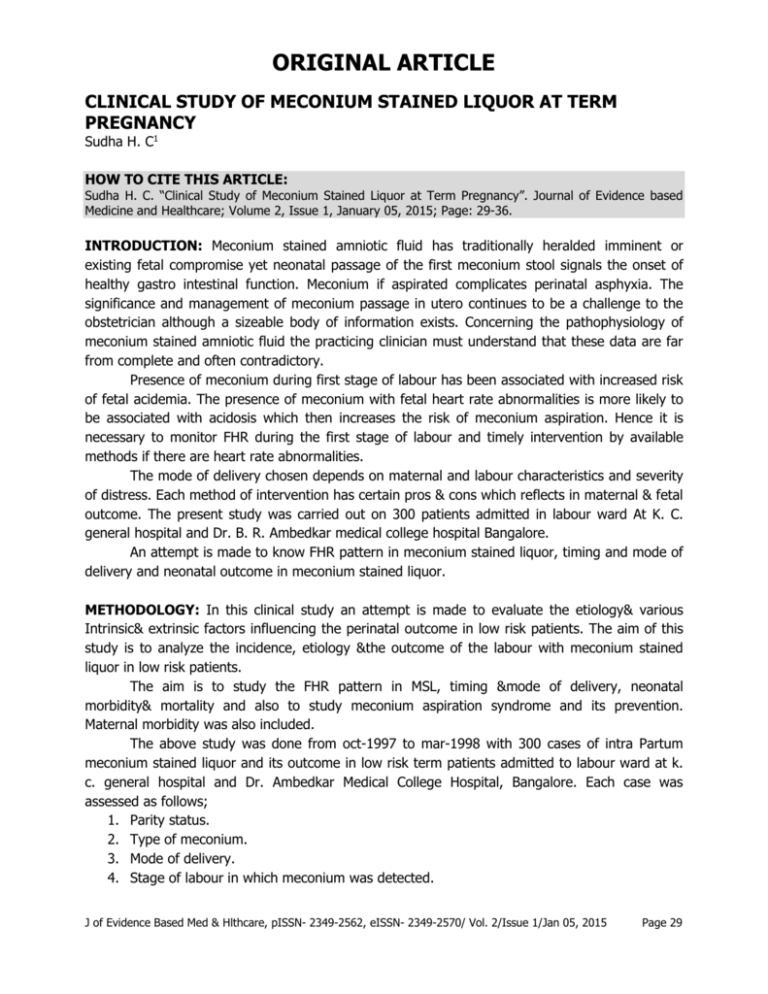
ORIGINAL ARTICLE CLINICAL STUDY OF MECONIUM STAINED LIQUOR AT TERM PREGNANCY Sudha H. C1 HOW TO CITE THIS ARTICLE: Sudha H. C. “Clinical Study of Meconium Stained Liquor at Term Pregnancy”. Journal of Evidence based Medicine and Healthcare; Volume 2, Issue 1, January 05, 2015; Page: 29-36. INTRODUCTION: Meconium stained amniotic fluid has traditionally heralded imminent or existing fetal compromise yet neonatal passage of the first meconium stool signals the onset of healthy gastro intestinal function. Meconium if aspirated complicates perinatal asphyxia. The significance and management of meconium passage in utero continues to be a challenge to the obstetrician although a sizeable body of information exists. Concerning the pathophysiology of meconium stained amniotic fluid the practicing clinician must understand that these data are far from complete and often contradictory. Presence of meconium during first stage of labour has been associated with increased risk of fetal acidemia. The presence of meconium with fetal heart rate abnormalities is more likely to be associated with acidosis which then increases the risk of meconium aspiration. Hence it is necessary to monitor FHR during the first stage of labour and timely intervention by available methods if there are heart rate abnormalities. The mode of delivery chosen depends on maternal and labour characteristics and severity of distress. Each method of intervention has certain pros & cons which reflects in maternal & fetal outcome. The present study was carried out on 300 patients admitted in labour ward At K. C. general hospital and Dr. B. R. Ambedkar medical college hospital Bangalore. An attempt is made to know FHR pattern in meconium stained liquor, timing and mode of delivery and neonatal outcome in meconium stained liquor. METHODOLOGY: In this clinical study an attempt is made to evaluate the etiology& various Intrinsic& extrinsic factors influencing the perinatal outcome in low risk patients. The aim of this study is to analyze the incidence, etiology &the outcome of the labour with meconium stained liquor in low risk patients. The aim is to study the FHR pattern in MSL, timing &mode of delivery, neonatal morbidity& mortality and also to study meconium aspiration syndrome and its prevention. Maternal morbidity was also included. The above study was done from oct-1997 to mar-1998 with 300 cases of intra Partum meconium stained liquor and its outcome in low risk term patients admitted to labour ward at k. c. general hospital and Dr. Ambedkar Medical College Hospital, Bangalore. Each case was assessed as follows; 1. Parity status. 2. Type of meconium. 3. Mode of delivery. 4. Stage of labour in which meconium was detected. J of Evidence Based Med & Hlthcare, pISSN- 2349-2562, eISSN- 2349-2570/ Vol. 2/Issue 1/Jan 05, 2015 Page 29 ORIGINAL ARTICLE 5. Aetection to delivery interval. 6. Neonatal outcome at birth. 7. Neonatal complications. 8. Maternal complications. 9. Need for nicu care. 10. Average length of nicu stay. The parity status of women was considered to plan for active management by judicial intervention in reducing the incidence of fetal distress. Thick or light meconium. Thick meconium is defined as turbid &viscous and particulate. Light meconium was watery & thinly stained. Mode of delivery included spontaneous vaginal, forceps application and cesarean section. ventouse application was not used as it was not available in our institution. Fetal heart rate was monitored in about 80% of the patients and by ordinary Stethoscope In those patients who had imminent delivery or where FHR monitor Was not available. The mean cervical dilatation when the meconium was detected was 4-5 cm after rupture of membranes either by ARM or SRM and the mean duration of labour was 3 hours 10 mins. Fetal heart rate abnormalities included tachycardia, bradycardia, variable late decelerations or combinations thereof. Estimations of fetal scalp ph and acid base status of fetus was not performed due to lack of facility available in our institution. Apgar scores were determined at 1&5min after birth. Apgar scores.>7 was considered normal. Diagnosis of meconium aspiration syndrome was made on the basis of presence of meconium in trachea, subsequent respiratory distress and an abnormal chest x-ray of neonate Neonatal morbidity &mortality and duration of nicu stay were noted and all these criteria were submitted to a statistical analysis. J of Evidence Based Med & Hlthcare, pISSN- 2349-2562, eISSN- 2349-2570/ Vol. 2/Issue 1/Jan 05, 2015 Page 30 ORIGINAL ARTICLE Table-2 shows method of rupture of membranes arm was done in 143 patients 103 patients had spontaneous rupture of membranes while 39 patients had prom 15 cases were taken for elective c section where meconium was seen accidentally In all prom cases labour was accelerated by syntonon drip. Out of39 patients 20 of them delivered vaginally. 6 of them required forceps application and 13 of them. Were taken for c. section due to failure of progress. In patients who had spontaneous rupture of membranes, 89 of them delivered Vaginally, 9 of them required forceps application and only 5 patients had c. section. Table-3 shows stage of labour at which meconium was detected out of total 207 cases of thick meconium, 127 were found having 0-5 cm cervical dilatation while 54 cases were found having 5-10cm cervical dilatation, out of total 93 cases of thin meconium, 40 were detected 0-5 cervical dilatation while 48 were at 5-10cm dilatation. Table-4 shows fhr pattern in relation to type of meconium base line fhr was recorded in 177 cases of thick meconium while in 71 cases of thin meconium groups. J of Evidence Based Med & Hlthcare, pISSN- 2349-2562, eISSN- 2349-2570/ Vol. 2/Issue 1/Jan 05, 2015 Page 31 ORIGINAL ARTICLE Table-5 shows time in hours from detection of meconium to delivery interval Total spontaneous delivery was 177 out of them 126 patients delivered within ½ To1 hour while 36 delivered in 1-2 hour. 15 patients had delivery between 2-3 hour after detection of meconium. Table-6 shows mode of delivery in relation to type of meconium. 108 cases were thick meconium groups and 69 cases were thin meconium group who had spontaneous vaginal delivery. Out of 60 forceps cases, 43had thick meconium and17 had thin meconium. Out of 63 csection cases 45 patients had thick meconium while 18 had thin meconium. J of Evidence Based Med & Hlthcare, pISSN- 2349-2562, eISSN- 2349-2570/ Vol. 2/Issue 1/Jan 05, 2015 Page 32 ORIGINAL ARTICLE Table-7 shows apgar score at birth in relation to type of meconium there was no significant change in apgar score between 1&5 min. so apgar scoring was done at 5 min of birth. Table-8 shows neonatal out come at birth laryngeal suction was done in almost all the babies. Table 9 shows relationship of detection to delivery interval with meconium aspiration syndrome. J of Evidence Based Med & Hlthcare, pISSN- 2349-2562, eISSN- 2349-2570/ Vol. 2/Issue 1/Jan 05, 2015 Page 33 ORIGINAL ARTICLE DISCUSSION: As per table no 10 incidence of thick & thin meconium is comparable to other studies (1). Intra partum f hr pattern is compared with other studies(2) in table no 11. Different mode of delivery in this study are compared with that of abramovici et al study done by Rosario mc and sheshadri(3,4). l in 1996 showed 50 cases of thick & 50 cases of thin meconium group infants apgar scoring system. 99 infants had Apgar score more than 6 &one J of Evidence Based Med & Hlthcare, pISSN- 2349-2562, eISSN- 2349-2570/ Vol. 2/Issue 1/Jan 05, 2015 Page 34 ORIGINAL ARTICLE infant of thick meconium group had less than 6 Apgar score who died of meconium aspiration syndrome. They found no significant change in 1 & 5 min apgar score had taken only 5 min apgar score. Syke; s et al in 1982 in his study of 200 deliveries showed 21% of the neonate. With 1 min apgar score of <7 &had severe acidosis at delivery as evidenced by An umbilical arterial ph of <7.10 and a severe base deficit. On the other hand 75% of the infants without significant acidosis had an apgar score of>7. Occurrence of meconium below the vocal cord is compared with other studies in table no-13(1). The purpose of this prospective study was to identify the prenatal and Perinatal factors that identify the fetus at risk for meconium aspiration syndrome in a large tertiary teaching hospital.(2,5) J of Evidence Based Med & Hlthcare, pISSN- 2349-2562, eISSN- 2349-2570/ Vol. 2/Issue 1/Jan 05, 2015 Page 35 ORIGINAL ARTICLE CONCLUSION: In this study it is found that there is increased perinatal mortality & morbidity in MSAF. Analysis of results showed that significantly more women with thick meconium stained liquor in labour were found to have fetal distress as diagnosed by fetal heart rate abnormalities and had some instrumental or operative intervention to cut short labour. However there was no significant difference in neonatal morbidity apgar scores & nicu stay. We therefore, suggest continuous electronic fetal monitoring of all low risk thick msaf in labour. If fetal distress is diagnosed early operative intervention will help to reduce the risk of meconium aspiration. In conclusion the presence of meconium in amniotic fliud without signs of Fetal asphyxia (late deceleration & acidosis) is not a sign of fetal distress and need not be an indication for active intervention. In this study, it resulted in Lower perinatal morbidity &lower intervention rates during labour. A bad Neonatal outcome will only be prevented by vigilant intrapartum care & active suctioning of the infants airway at birth. REFERENCES: 1. A selective approach to the neonate exposed to meconium stained Amniotic fluid thomascc; peng; gary, gutchersam j. obst. gynecol 1996; 175; 296; 303. 2. Meconium passage;a new classification for risk assessment during Labour paul. j. meis. marshall hall; & calvin am j obst. gynecol 131; 509; 1978. 3. Meconium as piration syndrome; intrapartum & neonatal attributes; etena. m. Rossi, Elliot, h. ph hillipson, Thomas: am. j: obst, gynecol: 1989: 161; 1106-10. 4. Abramovici. h., brandes jm, fuch’s k.et al meconium during delivery a Sing of compensated fetal distress. 5. Fogsi journal sep 1996; rasariomc; sheshadri. l; meconium staining amniotic fliud in low risk parturients 642-646. AUTHORS: 1. Sudha H. C. PARTICULARS OF CONTRIBUTORS: 1. Assistant Professor, Department of Obstetrics and Gynaecology, Bangalore Medical College and Research Institute. NAME ADDRESS EMAIL ID OF THE CORRESPONDING AUTHOR: Dr. Sudha H. C, # 936, 21st Main Road, J. P. Nagar, 2nd Phase, Bangalore - 78. E-mail: drsudha69@gmail.com Date Date Date Date of of of of Submission: 22/11/2014. Peer Review: 24/11/2014. Acceptance: 26/11/2014. Publishing: 01/01/2015. J of Evidence Based Med & Hlthcare, pISSN- 2349-2562, eISSN- 2349-2570/ Vol. 2/Issue 1/Jan 05, 2015 Page 36
